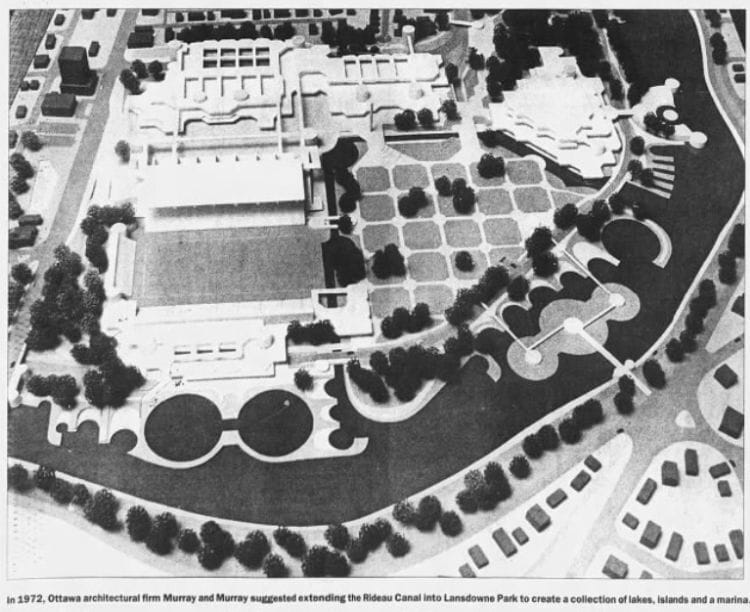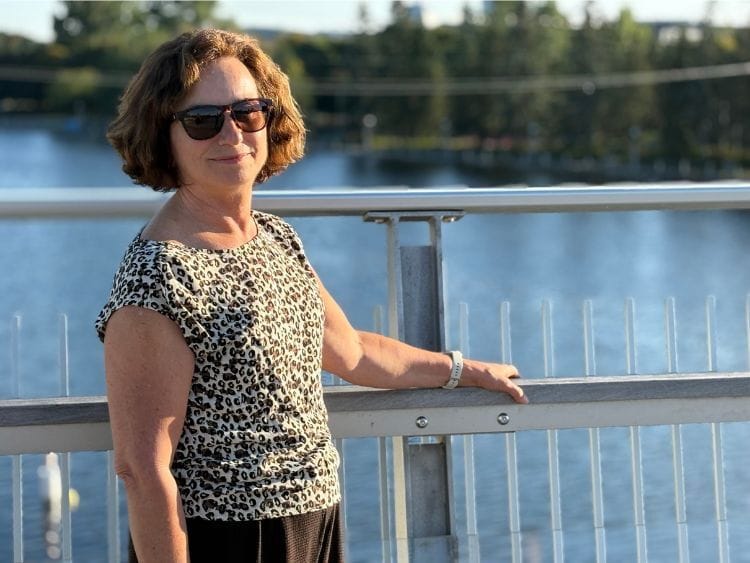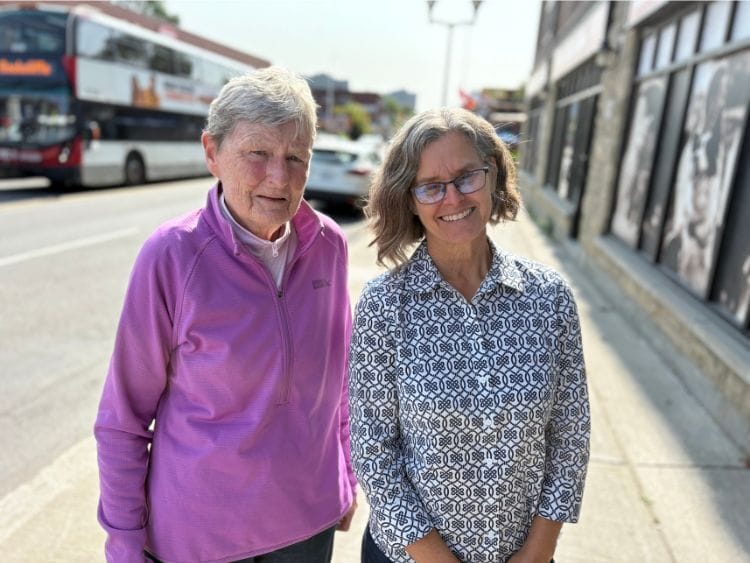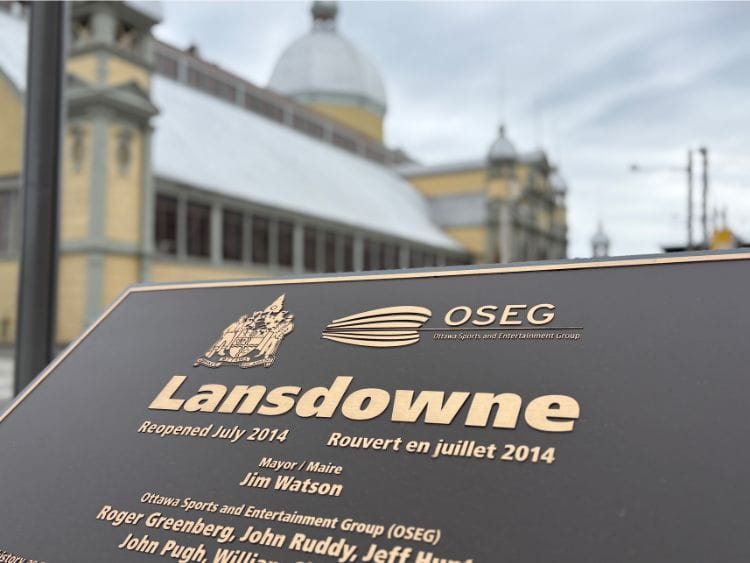For decades, one question has plagued city hall: What should we do with Lansdowne Park?
Talk of revitalization began in 1972, when the City of Ottawa asked architectural firm Murray and Murray to produce a plan that would turn the 63-acre park into a place that could be used for leisure, recreation and entertainment.
The vision was bold. It would have seen the historic Rideau Canal extend further into Lansdowne and include a collection of islands, lakes, and even a marina. It borrowed examples from Battersea Park in London, England, and Tivoli Gardens in Copenhagen.
The architect wanted to create a beach-like feel and a place where people could launch canoes and kayaks. In their vision, there would be swimming pools, skating rinks, cafes and fountains, and in the middle, a centrepiece called the Golden Triangle: a midway surrounded by water where various forms of entertainment would take place.
Many Ottawa residents loved the idea; the City, not so much. Despite the idea winning a national design award, then-Mayor Charlotte Whitton laughed at the idea and said Ottawa wasn’t the Bank of Canada.

Drawings show what was envisioned for Lansdowne Park in 1972. Credit: Ottawa Citizen archives on newspapers.com
Then, in 1996, Lansdowne was becoming a financial drain to the city — a reputation the park has yet to shed. Multiple drawings and proposals pitched condominiums, hotels, space for festivals, an outdoor amphitheatre, exhibition/trade show space, and, in at least one case, the football field being built on the roof of the trade show building.
Three bidders came forward. All had plans to remove the sporting components, including the Frank Clair Stadium, and instead fill the park with offices, condos and retail; the other half of the park would have been handed over to developers.
It even came close to reaching fruition. There were plans to build 660 houses and a 100,000 square-foot office tower, and to refurbish the Civic Centre into a smaller 5,500-seat arena with underground parking for 1,500 vehicles. There would be some green space and lagoons, too.
At the time, then-mayor Jim Watson supported the development. But Bob Chiarelli, who was regional chair at the time, advocated for Lansdowne Park to be preserved as it was, and the development plans eventually died.
In 2007, structural cracks were found in the southern stands of the Frank Clair Stadium, which triggered a renewed interest in a comprehensive redevelopment. The new park design, Lansdowne 1.0, was also highly controversial and saw appeals and heated council meetings not unlike the ones that have been occupying City Hall more recently.
Lansdowne 1.0 became fully operational by 2014, but it did not take long for critics to point out that it wasn’t pulling in as much revenue as expected.
Then came plans for Lansdowne 2.0, which will go to council for a final vote today.
If passed, two new residential towers would be built on the site bordering Bank Street – and the sale of the air rights above the towers would help pay for the development. A new, smaller hockey arena would be built where the “great lawn” currently sits, and slightly smaller North-side, open-air stands would also be replaced..
Every community association that borders the Glebe community has opposed the plans, saying it would take away precious greenspace and make it more costly to attend sporting games given the reduced seats. Many also question the short- and long-term financial return of a project with such a high price tag.
The Ottawa Lookout sat down with the Glebe, Old Ottawa South, and Old Ottawa East Community Associations to hear what they think should be done instead, and what challenges their neighbourhoods would face if councillors approve the project today.
Glebe Community Association

Carolyn Mackenzie chairs the Glebe Community Association’s planning committee. Photo by Charlie Senack.
Carolyn Mackenzie, who chairs the Glebe Community Association’s planning committee, says there are a lot of city needs that need to be addressed. Recreation centres are aging and in need of repairs. There are potholes, a lack of transit in many neighbourhoods, and a social service crisis downtown.
The total price tag for Lansdowne 2.0 is $418.8 million, with the cost to taxpayers around $130 million – or $4.3 million a year. While that is only a fraction of the entire cost, Mackenzie said that money can be used in more effective ways. After all, Mayor Mark Sutcliffe said only a year ago the city was in an affordability crisis.
“In the short- to medium-term, it is going to be taxpayers picking up the bill, but besides the finances, it is just not a good project,” Mackenzie told the Lookout. “The new smaller facilities will lead to higher ticket prices, and Ottawa Charge fans will not all be able to attend games because there are a few thousand fewer seats in the new arena.”
There is also concern over the lack of greenspace that will come as a result of the Great Lawn being removed for development. Roughly half of the lawn will be lost to the new arena, including the berm, which is used in the summer for concert events and in the winter as a toboggan hill for neighbourhood kids.
“In many downtown neighbourhoods we are adding people, we're intensifying, as we should be doing. But with that, we need to have greenspace. We need more parkland in the urban core, not less,” said Mackenzie.
Instead of tearing down and building new, Mackenzie said she feels the City should look at what they can do with the current facilities.
“What can we do on-site to make it a more welcoming and fun place for people to come and enjoy themselves?” she said. “According to the engineering reports, they have quite a bit of life left in them. There's no urgency to pull down those facilities; they're absolutely safe.”
There has been lots of confusion over if repairs are even possible;in a memo sent out on Thursday, city manager Wendy Stephanson said “maintaining the facilities while remaining competitive as one of Ottawa’s principal sports and entertainment facilities is not feasible.”
The TD Place arena was built in 1967 and is the second-oldest municipal arena in Ontario, Stephanson said, and while she noted that the structures remain safe and structurally sound, “they are functionally obsolete and no longer operationally suited to the requirements or expectations of modern event organizers, athletes, performers, or guests.”
Some of those issues include narrow corridors, a lack of washroom facilities and premium seating, and only one elevator serving the upper levels of the north-side stands.
Old Ottawa East Community Association

Alexandra Gruca-Macaulay is chair of the Lansdowne committee for the Old Ottawa East Community Association. Photo by Charlie Senack.
Alexandra Gruca-Macaulay, chair of the Lansdowne committee for the neighbouring Old Ottawa East Community Association, also said she worries about the project's finances. A little over a decade ago, the City spent $200 million to revitalize the site. But now, some of that work will be torn down, including the retail component next to TD Place arena and much of the landscaping.
“There are needs across Ottawa and many communities would be very happy to have a little piece of money to make their lives better,” Gruca-Macaulay told the Ottawa Lookout.”We have a situation in our neighbourhood where we've got a combined sewer water system that when it rains heavily, there are what they call events of overflow into the Rideau River Where the dock is at Clegg Street where paddlers go in.”
“It would be great to have a fraction of those funds to solve the issue.”
Stittsville Coun. Glen Gower, who is vice-chair of the Planning and Housing Committee, has said that if Lansdowne 2.0 is not realized, the city will not collect revenues from the new development, and therefore, the funds cannot be reallocated elsewhere. City staff also said that the portion of funds sourced from taxpayers cannot be simply redistributed to other City projects — to do so would require an overhaul of the annual budget.
When Lansdowne 1.0 was built over a decade ago, its goal was to be an economic driver for the city, drawing in over $100 million in profits. But that never happened, and 2024 saw another $9.2 million loss, according to the 2024 Lansdowne annual report. Recently released statistics showed a $11.1 million net loss for the 2024-25 fiscal year.
Meanwhile, Lansdowne 2.0 is forecasted to bring in more than $350 million in profits, which, in theory, will offset some of the costs of building. The City says much of that will come from money it earns through the site's retail – which is only increasing by two per cent – and selling some of Exhibition Way to a developer. The City then plans to regain Exhibition Way again later through a covenant in the agreement.
But as community organizer Neil Saravanamuttoo pointed out, such an agreement from 1981 is not helping the residents of Kanata, for example, who are fighting to save their golf course from development.
The proposed development has already been scaled back due to costs. Gone is the green roof idea on the new arena, which staff estimated would cost between $4 million and $28 million to build. Mayor Mark Sutcliffe argued it was “only an option,” but Ottawa Sports and Entertainment Group has confirmed it was part of the original plan.
Gruca-Macaulay thinks accessibility improvements should be made to the current Lansdowne site and says there needs to be more public consultations to get a feel for what actual Ottawa residents want to have happen there.
There are already hugely successful farmers’ and flea markets in the summer and the European-style Christmas market in the winter, which Gruca-Macaulay thinks the park needs more of in order to turn a profit.
“There's such energy already there, and then the vibe is amazing when those activities happen. But go any other day of the week if there is not a special event going on,and it’s like a ghost town,” said Gruca-Macaulay. “I've laughed with some of my friends that walking through that plaza by the Aberdeen Pavilion almost feels like you're walking to a Stephen King movie or something because of the emptiness and weird ambiance music they play.”
Gruca-Macaulay used to live in Kanata but moved to Old Ottawa East a decade ago and said she has no regrets. But one component she misses from suburbia is the attention to public greenspace and trees; there are not many parks in her Main Street area neighbourhood, and she said many children and families walk over the Flora Foot Bridge to use the Great Lawn at Lansdowne.
“It is going to be shrunk by 48,000 square feet. That will be a huge loss to our community because I see people using it all the time,” she said.
Old Ottawa South Community Association

Susan Neill (left) and Susan Mendelsohn (right) are with the Old Ottawa South Community Association. Photo by Charlie Senack
If Lansdowne 2.0 passes, it will mean close to a decade of construction along Bank Street, and that’s not an idea that many locals are in favour of.
Shovels would break ground on the new event centre almost immediately, and the building is expected to take 23 months to construct. The north side stands, retail podium, and parking that would take an additional 30 months. The final phase would then be the two highrises.
“The site already has a traffic and transit issue that has existed since the initial development,” said Susan Mendelsohn, president of the Old Ottawa South Community Association. “There are traffic jams after every game or event. There are safety issues as people drive the wrong way.
“There is no solution to any of that in the Lansdowne 2.0 proposal. It is very frustrating when you can't get out of your neighbourhood because of traffic jams.”
Susan Neill, chair of the Lansdowne Working Group for the Lansdowne Community Association, said she also has concerns over the two residential towers casting shadows over the park and the increased traffic caused by the 770 new residential units.
“I think it is too many people to fit into such a small space. It is going to bring even more cars to Bank Street,” All these people are not going to just be walking and cycling,” she said. “That is not to mention the increase in Uber and Amazon deliveries turning into the site.”
The Old Ottawa South Community Association has written multiple letters to Mayor Sutcliffe in an attempt to have their concerns addressed, but Mendelsohn said they never received a reply.
Mendelsohn added she would like to see a better mix of niche shops at Lansdowne Park and likes the idea of seeing how the canal could be better integrated into the site.
“The recreational potential for the site is just phenomenal. It has the word “park” in the title for a reason. And when it comes to shopping, I would like to see something better than the big-box retail we currently see there,” she said.
The vote
When elected officials march into council chambers this morning, most already know how they plan to vote on the Lansdowne 2.0 file. Unless anything drastic changes, it is likely to pass.
Most councillors have remained consistent with where they stand on the file.
Mayor Mark Sutcliffe has said since the 2022 municipal election that he is in support of the project.
Orléans-East Cumberland Coun. Matt Luloff has told the Lookout he thinks Lansdowne 2.o needs to happen so the city can attract bigger events like the Invictus Games.
Barrhaven West Coun. David Hill has said the cost of passing on the development is too high.
Orléans West-Innes Coun. Laura Dudas, Kanata North Coun. Cathy Curry, Stittsville Coun. Glen Gower, Beacon Hill-Cyrville Coun. Tim Tierney, and Orléans South-Navan Coun. Catherine Kitts have also all indicated they will vote yes. Riverside South-Findlay Creek Coun. Steve Desroches has not said how he will vote, but has spoken in favour of the plans in the past.
Bay Ward Coun. Theresa Kavanagh, College Ward Coun. Laine Johnson, Knoxdale-Merivale Coun. Sean Devine, Gloucester-Southgate Coun. Jessica Bradley, Rideau-Rockcliffe Coun. Rawlson King, Somerset Coun. Ariel Troster, and Capital Ward Coun. Shawn Menard have remained opposed and said they will vote no. Barrhaven East Coun. Wilson Lo voted yes to Lansdowne in the past, but has confirmed to the Lookout his vote will be no, despite supporting some parts of the plan.
Kanata South Coun. Allan Hubley and River Ward Coun. Riley Brockington have both said they will not yet reveal how they plan to vote.
There is some speculation as to how Osgoode Coun. Isabelle Skalski intends to vote. During this year’s byelection in Osgoode, she spoke out against the project, but recently she told the Lookout that since speaking with city staff, her views have changed.
Rideau-Jock Coun. David Brown recently told the Lookout he remains undecided as to how he’d vote, but he has expressed concerns over some of the financials. Alta Vista Coun. Marty Carr also said she is undecided, but she has spoken favourably about the project in the past. The Lookout reached out to both for comment, but did not hear back ahead of publication. Rideau-Vanier Coun. Stephanie Plante has indicated her views are mixed and will vote accordingly.




